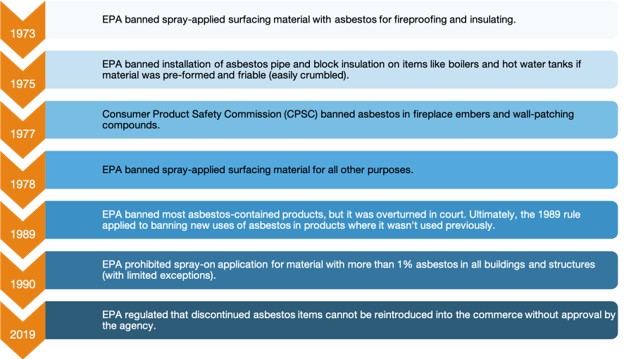
Can you sue for asbestos exposure at work or at home?
Asbestos was used throughout the 20th century in the U.S. as a common material for construction and manufacturing. The benefits to asbestos in those industries were clear — it was used because its fibers are strong but not heavy, and it provides both insulation and fire-resistant qualities.
But what they didn’t know was just how harmful it is to human health.
Asbestos is no longer used in the U.S. in new construction or manufacturing, but it’s still present in many older buildings and homes. Health hazards exist under certain conditions for people who live in homes or work in buildings with asbestos, or those whose jobs could pose an exposure risk.
What are the health hazards from asbestos?
Asbestos enters the human body when a person inhales microscopic fibers (dust).
Once inhaled, these fibers can enter the lower region of the lungs and cause asbestosis lung disease, changes in the lining of the chest cavity, lung cancer, and mesothelioma.
There are 3 primary ways people become exposed to asbestos:
- Occupational exposure that happens from toxins in the workplace.
- Property contamination when you’ve become ill from asbestos in your home during a renovation or for some other reason.
- Personal care items and cosmetics can cause asbestos-related illnesses. Talcum powder has been shown to contain asbestos, and lawsuits have been filed by women who claimed to have contracted ovarian cancer because of daily use. There are also recent instances where the U.S. Food and Drug Administration found asbestos in cosmetics marketed to young women and teens.
It’s also possible to be diagnosed with secondary mesothelioma. For example, a person goes to work in a factory each day and is exposed to asbestos fibers in the manufacturing process. When that person returns home, the fibers might still be present on their shoes and clothes, and could contribute to mesothelioma in a family member who’s exposed to those items.
What is mesothelioma?
Mesothelioma is a type of lung cancer that generally affects people who’ve been exposed to asbestos.
Mesothelioma is usually fatal, but symptoms often don’t appear until 30 to 40 years after exposure. In many cases, symptoms appear sooner when there’s a higher level of exposure.
Symptoms of mesothelioma include:
- Chest, shoulder, or abdominal pain
- Dry cough or wheezing
- Weight loss
- Fever or night sweats
- Trouble breathing or shortness of breath
- Fluid around the lungs (pleural effusion)
- Fatigue and muscle weakness
How is mesothelioma diagnosed?
In many cases, a doctor observes signs of mesothelioma in a patient who goes to the doctor for another reason. Sometimes, a patient might get an X-ray or blood test that shows something unusual that causes the doctor to suspect mesothelioma. If the doctor suspects that you have mesothelioma, a biopsy can provide confirmation.
Mesothelioma is often undiagnosed before stage 3 or stage 4 because symptoms like chest pain, weight loss, and fatigue appear as a result of tumors pressing against nerves, organs, and bones. Once that begins to happen, the disease is already fairly progressed.
Occasionally, there’s enough fluid buildup around the lungs in stage 1 or stage 2 mesothelioma that a patient might experience shortness of breath or coughing that can lead to an earlier diagnosis.
Other types of mesothelioma
The most common type of the disease is pleural mesothelioma, which affects the lungs. There are other parts of the body that could be affected by mesothelioma, including:
- Peritoneal mesothelioma, which affects the abdominal organs and can result in abdominal fluid backups, hernias, loss of appetite, bowel obstruction, and other symptoms.
- Pericardial mesothelioma, which develops in the lining of the heart (pericardium).
- Testicular mesothelioma, which accounts for fewer than 1% of all mesothelioma cases. This form of the disease is characterized by a lump in the testicles, and symptoms include a lump in the scrotum, testicular pain and swelling, and fluid in the scrotum.
Treatment for mesothelioma and asbestos-related illnesses
There are 3 primary treatments for mesothelioma:
- Surgery
- Chemotherapy
- Radiation
Some patients are also given multimodal treatment, which involves a combination of treatment options.
Patients who are diagnosed in the early stages of mesothelioma are most likely to benefit from surgery to remove the tumors from their chest cavities.
Researchers are continually evaluating new and improved methods for treating mesothelioma. There are experimental treatments available, and it’s possible that these options could become conventional treatments in the future.
Where was asbestos used?
In the building/construction industry, the most common ways for asbestos to be used were:
- Vinyl floor tiles and sheet flooring
- Vinyl wallpaper
- Adhesives in roofing sealant, pipe lagging, ceiling tiles, interior fixtures, furnace cement, wall panels, and flooring glue
- Duct connectors for heating, ventilation, and air conditioning (HVAC)
- Corrugated cement, flat cement, drywall, and roof shingles and siding
- Electrical components
- Felt in roofing, flooring, and paper mills
- Loose-fill, block, and spray-on insulation and acoustic tiles
- Heat-resistant seals and gaskets for machine parts, valves, and hoses
Asbestos can also be contained in plastics and textiles like protective clothes, fire blankets, and fire-retardant upholstery, along with tools, cookware, appliances, and cars.
In addition, asbestos has been found in:
- Cigarette filters (until 1956)
- Home products like pot holders, wicking for gas ranges, fake snow for holiday decorations, insulation in hair dryers and cookware
- Makeup and cosmetics
- Talcum powder (i.e. baby powder and other personal hygiene items)
- Laboratory equipment like insulation linings, Bunsen burner mats, and gloves
What are the rules about asbestos today?
The Environmental Protection Agency (EPA) took action against asbestos beginning in 1973.

Houses built between 1930 and 1950 could still have asbestos in the insulation. It could also be in some textured paints and compounds in wall or ceiling joints. Use was banned in 1977, but it might still be present in homes built before that time.
Should I be concerned about asbestos in my older home causing mesothelioma?
Asbestos is only hazardous when you breathe it in.
If your tiles, insulation, or other asbestos-containing materials are sealed, the asbestos isn’t airborne. Asbestos is only dangerous when it crumbles into dust or powder. If you suspect there might be asbestos in your home, it’s best to consult a professional before beginning any major home improvements that involve demolition of the walls or other parts of your home.
Could I be exposed to asbestos in my workplace today?
Yes, you can still be exposed to asbestos. Even though asbestos is more tightly regulated than ever before, the Occupational Health and Safety Administration (OSHA) estimates that 1.3 million Americans are exposed to significant amounts of asbestos in the workplace each day.
Tweet this
If you could be exposed to asbestos at work, your employer should provide personal asbestos exposure monitoring, protective equipment, proper ventilation, hazard warning signs, and medical monitoring.
Ordinarily, any injury that happens in the workplace would be covered under a workers’ compensation claim. However, if your asbestos injury leaves you with catastrophic or permanent illness, you might be better off with a personal injury lawsuit. A lawyer can advise about what your best option would be.
If you work in a field that could involve asbestos exposure, know that you could also be exposing your family members.
Anyone who lives in your home could be exposed to asbestos — and therefore at risk for the same illnesses as someone who works directly with the substance — if you’re bringing microscopic asbestos fibers home on your clothes or shoes.
The good news is that regulations regarding asbestos safety have improved. Employers today are required to provide facilities where workers can change out of contaminated clothes, take showers to wash asbestos fibers off their hair or skin, and have special laundry services to clean contaminated work clothes or uniforms. Workers are advised that they shouldn’t wash their own contaminated clothes at home.
However, a family member of someone who was exposed to asbestos in the workplace before these regulations took effect could experience symptoms of mesothelioma or other asbestos-related illness now as a result of secondary exposure many years ago.
If you have symptoms of mesothelioma or other asbestos-related illness, be sure to tell your doctor if you lived with someone who might’ve been exposed in the workplace, even if you have never worked in that capacity.
Mesothelioma and asbestos lawsuits
If you’ve been diagnosed with mesothelioma, you’re probably wondering if there are legal options for compensation.
There are several types of mesothelioma lawsuits:
- Personal injury. In a personal injury lawsuit, the patient would file a suit against the company responsible for their asbestos exposure.
- Wrongful death. This can be filed by a surviving family member of someone who died as a result of mesothelioma. The survivor can claim damages for medical bills, funeral expenses, lost income, loss of consortium, and other costs.
- Class action. A class action lawsuit is shared among a group of people who have similar injuries caused by the same harm. An individual person can opt into a class action lawsuit.
- Multidistrict litigation (MDL). An MDL is similar to a class action because it involves multiple people who have claims based on similar injuries. The difference is that they’re each filing an individual claim, rather than being gathered into a single lawsuit. Even though each case has an individual plaintiff, the cases are grouped together so the court hears evidence and details that apply to all cases, which makes the process faster for everyone.
Your lawyer can advise on the best method for you to pursue a mesothelioma lawsuit.
Am I eligible for a mesothelioma lawsuit?
Any personal injury lawsuit hinges on causation, or proof that the defendant’s actions were the cause of the plaintiff’s injury. That’s what makes a mesothelioma lawsuit complicated — because the nature of the illness is that symptoms don’t appear for years or decades after exposure, it can be hard to link the exposure to the disease or even prove that you were exposed to asbestos at all.
Usually, there are 2 elements to being eligible for a mesothelioma lawsuit:
- Mesothelioma diagnosis
- Asbestos exposure history
The statute of limitations varies by state but begins to run on the date of your diagnosis. Once diagnosed, consult a lawyer to find out how long you have to file a mesothelioma lawsuit in your state.
The documents you’ll need to present to the court will include medical records, employment documents, and testimony and details about the asbestos exposure. You’ll also need to present documentation of costs related to your medical treatment and other financial damages.
 Documents & Evidence Checklist
Documents & Evidence Checklist
Checklist of 30 items to help you prepare for making a personal injury or accident claim
Download in PDF format![]()
In order to prove that the defendant would be the liable party for the asbestos exposure, your lawyer might apply the “frequency, regularity, proximity” test set forth in the Lohrmann v. Pittsburgh Corning Corp. case in 1985.
If you’ve been in multiple workplaces and could’ve been exposed to asbestos in more than one, the court would look for evidence to prove:
- Exposure to a specific product that belongs to a particular defendant;
- On a regular basis over an extended period of time;
- At the location where the plaintiff worked and was exposed;
- In a way that is likely to have caused the exposure that led to the plaintiff’s illness.
What to do if you’re diagnosed with mesothelioma or other asbestos-related illness
Even if you’re no longer working, you might still be able to receive compensation. A personal injury lawyer can investigate your occupational history and determine when you were most likely exposed to asbestos and who the responsible parties would be.
Your rights could include compensation from:
- A trust fund set up by companies that have liability for asbestos exposure
- Veterans’ benefits
- Workers’ compensation (even if you’re retired)
The Enjuris Personal Injury Law Firm Directory can help you find a lawyer near you who will advise you about your rights, what your best options are for pursuing a mesothelioma lawsuit or settlement, and what to do next.
Connect to top-rated lawyers in seconds using our comprehensive national directory
See our guide Choosing a personal injury attorney.
